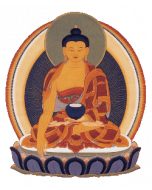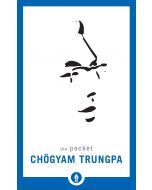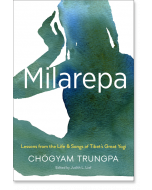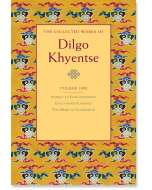The Collected Works of Chogyam Trungpa
The Collected Works of Chögyam Trungpa brings together in ten volumes the writings of one of the first and most influential and inspirational Tibetan teachers to present Buddhism in the West. Organized by theme, the collection includes full-length books as well as articles, seminar transcripts, poems, plays, and interviews, many of which have never before been available in book form. From memoirs of his escape from Chinese-occupied Tibet to insightful discussions of psychology, mind, and meditation; from original verse and calligraphy to the esoteric lore of tantric Buddhism—the impressive range of Trungpa's vision, talents, and teachings is showcased in this landmark series.
Volume One contains Trungpa's early writings in Great Britain, including Born in Tibet (1966), the memoir of his youth and training; Meditation in Action (1969), a classic on the practice of meditation; and Mudra (1972), a collection of verse. Among the selected articles from the 1960s and '70s are early teachings on compassion and the bodhisattva path. Other articles contain unique information on the history of Buddhism in Tibet; an exposition of teachings of dzogchen with the earliest meditation instruction by Trungpa Rinpoche ever to appear in print; and an intriguing discussion of society and politics, which may be the first recorded germ of the Shambhala teachings.
Volume Two examines meditation, mind, and Mahayana, the "great vehicle" for the development of compassion and the means to help others. Chögyam Trungpa introduced a new psychological language and way for looking at the Buddhist teachings in the West. His teachings on human psychology and the human mind are included in this volume.
Volume Three captures the distinctive voice that Chögyam Trungpa developed in North America in the 1970s and reflects the preoccupations among Western students of that era. It includes Cutting Through Spiritual Materialism and The Myth of Freedom, the two books that put Chögyam Trungpa on the map of the American spiritual scene. The Heart of the Buddha and sixteen articles and forewords complete this volume.
Volume Four presents introductory writings on the vajrayana tantric teachings, clearing up Western misconceptions about Buddhist tantra. It includes three full-length books and a 1976 interview in which Chögyam Trungpa offers penetrating comments on the challenge of bringing the vajrayana teachings to America.
Volume Five focuses on the lineages of great teachers who have transmitted the Tibetan Buddhist teachings and on the practice of devotion to the spiritual teacher. It includes inspirational commentaries by Chögyam Trungpa on the lives of famous masters such as Padmasambhava, Naropa, Milarepa, Marpa, and Tilopa, as well as an excerpt from The Sadhana of Mahamudra, a tantric text that Chögyam Trungpa received as terma in 1968. Among the selected writings are "Explanation of the Vajra Guru Mantra," an article never before published, which deals with the mantra that invokes Guru Rinpoche; seminar talks available in book form for the first time; and previously unpublished articles on Milarepa.
Volume Six contains advanced teachings on the nature of mind and tantric experiences. Chögyam Trungpa's commentary on the Tibetan Book of the Dead explains what this classic text teaches about human psychology. Transcending Madnesspresents a unique view of the Tibetan concept of bardo. Orderly Chaos explains the inner meaning of the mandala. Secret Beyond Thought presents teachings on the five chakras and the four karmas. Glimpses of Space consists of two seminars: "The Feminine Principle" and "Evam." In the article "Femininity," the author presents a playful look at the role of feminine energy in Buddhist teachings. "The Bardo," based on teachings given in England in the 1960s, has not been available in published form for many years.
Volume Seven features the work of Chögyam Trungpa as a poet, playwright, and visual artist and his teachings on art and the creative process, which are among the most innovative and provocative aspects of his activities in the West. While it includes material in which Trungpa Rinpoche shares his knowledge of the symbolism and iconography of traditional Buddhist arts (in Visual Dharma), this richly varied volume primarily focuses on his own, often radical creative expressions. The Art of Calligraphy is a wonderful showcase for his calligraphy, and Dharma Art brings together his ideas on art, the artistic process, and aesthetics. Tibetan poetics, filmmaking, theater, and art and education are among the topics of the selected writings.
Volume Eight covers matters of culture, state, and society. The two complete books reprinted here— Shambhala: The Sacred Path of the Warrior and Great Eastern Sun: The Wisdom of Shambhala —explore the vision of an ancient legendary kingdom in Central Asia that is viewed as a model for enlightened society and as the ground of wakefulness and sanity that exists as a potential within every human being. The selected writings include discussions of political consciousness, the martial arts, and the true meaning of warriorship. Two previously unpublished articles are "The Martial Arts and the Art of War," on the place of warriorship in the Buddhist teachings, and "The Seven Treasures of the Universal Monarch," a little gem describing the world of the Shambhala monarch.
Volume Nine contains an extremely diverse group of teachings. It includes both early and later talks, from an article published in 1966 in India to books published in the new millennium to material from a set of cards that present the Shambhala warrior slogans. The subject matter ranges from Zen to dharma art, from Shambhala politics to Vajrayana buddhadharma. The selected writings in this book are articles from before Chögyam Trungpa’s death in 1987 and include two interviews and several previously unpublished pieces.
Volume Ten begins with Chögyam Trungpa’s three most recent books: Work, Sex, Money, Mindfulness in Action, and Devotion and Crazy Wisdom. The first two books in the volume emphasize the importance of meditation in action and bringing awareness, mindfulness, intentionality, and a sense of the sacred into everyday life. The third book explores devotion and discusses mutual commitment and surrendering between teacher and student. The selected writings in this volume range from older articles originally published in the Vajradhatu Sun to recently edited articles, including several that have not yet appeared in print. Overall, these articles show us how Trungpa Rinpoche worked deeply and directly with many interest groups and subsections of the community, and how he infused each situation with dharma, taking every opportunity to present essential teachings.
-
 Entering the Path$213.00
Entering the Path$213.00






